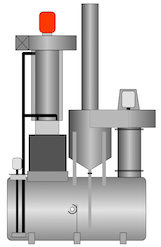LOW COST EVAPORATION SYSTEMS
Waste water that cannot be treated with conventional methods can almost always be evaporated at a low cost. The limiting factors are odour and initial TDS concentration. Pre-treatment can often remove odours and volatile contaminants. Our evaporators have unique features:
- Direct heat transfer. No metal surfaces to scale and/or corrode.
- No thermal degradation products that can create odours.
- High thermal efficiency system. Low equilibrium temperature prevents volatilization of contaminants.
- Simple and easy to operate. No special skills required.
- Low energy costs: Use natural gas, fuel oil, used oil, waste glycols, waste heat or combinations. Run blowers and pumps with hydraulic power from diesel or NG engines. Use waste heat from engine and exhaust for evaporation.
- Combine evaporator with liquid waste incinerators for ultimate energy efficiency and economy. Organic chemical wastes = energy.
- Wood waste can also be used as an energy source.
- Concentrates can be processed in "lean" liquid waste incinerator.
- Zero liquid discharge is optional when a small continuously operated concentrator is added. It can utilize waste heat. No heat transfer surfaces.
- Optional continuous oil removal.
- The newest designs include recovery of fugitive heat.
- Energy requirement is 3 GJ/m³ water evaporated. This varies somewhat with ambient temperatures.

Evaporators for Waste Water
Evaporation of waste water has special problems: Scaling, corrosion, thermal degradation of chemical and resulting emissions. Energy costs can also be substantial. Waste water from a variety of sources is usually an even bigger challenge. To achieve long sustained runs, it is necessary to implement "input control" and feed preparation. It is usually easier to prevent problems. This is where input control is so important. Know what can be processed without problems, and only accept waste waters that meet the acceptance criteria. Feed preparation is about removal of solid matter and VOC type contaminants. pH of the water may have to be adjusted to prevent corrosion and emission of certain types of chemicals.
Input Control
- Know how a waste is generated
- Establish a waste profile using screen tests
- Sample all shipments and perform screen tests. Compare to established profile
- Receive waste water and process the water to remove solids and VOCs. Adjust pH if required
- Determine volume reduction factor to apply by evaporation of a sample
Volume reduction factors depend on initial concentrations of TDS (total dissolved solids) and the nature of the TDS. Concentrates from the evaporation process can be solidified for land disposal, or they may have components that can be recovered. It is also possible to evaporate more water using crystallizers/dryers. Pre-treatment of waters is best done using methods that do not add TDS.Energy Sources
The Direct Heat Transfer Evaporator uses a hot gas as energy for evaporation. One of the great advantages of using fuels such as Natural Gas, Propane or Fuel Oil is that the evaporation equilibrium temperature can be kept low, usually in the 50 °C - 65 °C range. This prevents volatilization of many types of chemicals.
Waste Oils may be used to lower energy costs. There will be a somewhat higher capital cost for the waste oil burner part that has to be adapted to used oils. TSSA field approvals are non issues.
Hot gases from incinerators or biomass burners are also suitable energy sources. The best economics can be achieved when "lean" liquid waste is incinerated and the hot combustion gases are used for evaporation. Maximize revenues and minimize costs. New fuel is only used for primary ignition. Direct Heat Transfer evaporators also function as efficient scrubbers. Hot combustion gases are quenched very rapidly with the added benefit that temperatures do not remain in the Dioxin formation range.
Equilibrium temperatures depend on water content and temperature of the hot gas used. The more water, the higher the temperature. It is possible to recover some energy by pre-heating air or water. This will condense water.
Energy cost comparison in Ontario
1 m³ of natural gas = 37.3 MJ
1 L of oil = 37.8 MJ (LHV)
Used oil value per litre ≅ cost of 1 m³ of natural gas
Used oil = No carbon tax
1 L of used oil is worth ≅ cost of 1 m³ gas
At $0.14/m³ for gas, it cost ¢1.13/L to evaporate water
Reduce costs by generating power using a NG engine. Use all waste heat for evaporation
Operation
Direct Heat Transfer Evaporators are very simple to operate:
- Start re-circulation pump
- Start feed pump
- Start blower
- Start burner
- Set feed tank cutout level based on pre-determined volume reduction factor
Shutdown procedure starts with burner shutdown. Blower is shut down last.